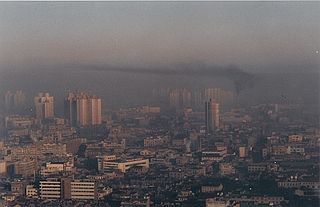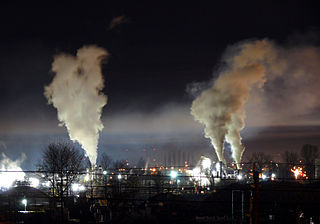Related Research Articles

A pollutant or novel entity is a substance or energy introduced into the environment that has undesired effects, or adversely affects the usefulness of a resource. These can be both naturally forming or anthropogenic in origin. Pollutants result in environmental pollution or become public health concerns when they reach a concentration high enough to have significant negative impacts.

Ground-level ozone (O3), also known as surface-level ozone and tropospheric ozone, is a trace gas in the troposphere (the lowest level of the Earth's atmosphere), with an average concentration of 20–30 parts per billion by volume (ppbv), with close to 100 ppbv in polluted areas. Ozone is also an important constituent of the stratosphere, where the ozone layer (2 to 8 parts per million ozone) exists which is located between 10 and 50 kilometers above the Earth's surface. The troposphere extends from the ground up to a variable height of approximately 14 kilometers above sea level. Ozone is least concentrated in the ground layer (or planetary boundary layer) of the troposphere. Ground-level or tropospheric ozone is created by chemical reactions between NOx gases (oxides of nitrogen produced by combustion) and volatile organic compounds (VOCs). The combination of these chemicals in the presence of sunlight form ozone. Its concentration increases as height above sea level increases, with a maximum concentration at the tropopause. About 90% of total ozone in the atmosphere is in the stratosphere, and 10% is in the troposphere. Although tropospheric ozone is less concentrated than stratospheric ozone, it is of concern because of its health effects. Ozone in the troposphere is considered a greenhouse gas, and may contribute to global warming.

Indoor air quality (IAQ) is the air quality within and around buildings and structures. IAQ is known to affect the health, comfort, and well-being of building occupants. Poor indoor air quality has been linked to sick building syndrome, reduced productivity, and impaired learning in schools. Common pollutants of indoor air include: Secondhand tobacco smoke, air pollutants from indoor combustion, radon, molds and other allergens, carbon monoxide, volatile organic compounds, legionella and other bacteria, asbestos fibers, carbon dioxide, ozone and particulates. Source control, filtration, and the use of ventilation to dilute contaminants are the primary methods for improving indoor air quality in most buildings.

Exhaust gas or flue gas is emitted as a result of the combustion of fuels such as natural gas, gasoline (petrol), diesel fuel, fuel oil, biodiesel blends, or coal. According to the type of engine, it is discharged into the atmosphere through an exhaust pipe, flue gas stack, or propelling nozzle. It often disperses downwind in a pattern called an exhaust plume.

The U.S. National Ambient Air Quality Standards are limits on atmospheric concentration of six pollutants that cause smog, acid rain, and other health hazards. Established by the United States Environmental Protection Agency (EPA) under authority of the Clean Air Act, NAAQS is applied for outdoor air throughout the country.
The Ministry of the Environment, Conservation and Parks is an Ontario government ministry responsible for protecting and improving the quality of the environment in the Canadian province of Ontario, as well as coordinating Ontario's actions on climate change. This includes administration of government programs, such as Ontario's Drive Clean and Clean Water Act. The ministry headquarters are located inside the Ontario Government Buildings.

An air quality index (AQI) is used by government agencies to communicate to the public how polluted the air currently is or how polluted it is forecast to become. AQI information is obtained by averaging readings from an air quality sensor, which can increase due to vehicle traffic, forest fires, or anything that can increase air pollution. Pollutants tested include particulates, ozone, nitrogen dioxide, carbon monoxide, sulphur dioxide, among others.

The Air Pollution Index is a simple and generalized way to describe the air quality, which is used in Malaysia. It is calculated from several sets of air pollution data and was formerly used in mainland China and Hong Kong. In mainland China the API was replaced by an updated air quality index in early 2012 and on 30 December 2013 Hong Kong moved to a health based index.

The Pollutant Standards Index (PSI) is a type of air quality index, which is a number used to indicate the level of pollutants in air.

Air pollution is the contamination of air due to the presence of substances in the atmosphere that are harmful to the health of humans and other living beings, or cause damage to the climate or to materials. It is also the contamination of indoor or outdoor surrounding either by chemical activities, physical or biological agents that alters the natural features of the atmosphere. There are many different types of air pollutants, such as gases, particulates, and biological molecules. Air pollution can cause diseases, allergies, and even death to humans; it can also cause harm to other living organisms such as animals and food crops, and may damage the natural environment or built environment. Air pollution can be caused by both human activities and natural phenomena.
The Índice Metropolitano de la Calidad del Aire or IMECA, in English meaning the Metropolitan Index of Air Quality, is the reference value system for the levels of air pollution in the Mexico City Metropolitan Area, within the Valley of Mexico.

Assimilative capacity is the ability for pollutants to be absorbed by an environment without detrimental effects to the environment or those who use of it. Natural absorption into an environment is achieved through dilution, dispersion and removal through chemical or biological processes. The term assimilative capacity has been used interchangeably with environmental capacity, receiving capacity and absorptive capacity. It is used as a measurement perimeter in hydrology, meteorology and pedology for a variety of environments examples consist of: lakes, rivers, oceans, cities and soils. Assimilative capacity is a subjective measurement that is quantified by governments and institutions such as Environmental Protection Agency (EPA) of environments into guidelines. Using assimilative capacity as a guideline can help the allocation of resources while reducing the impact on organisms in an environment. This concept is paired with carrying capacity in order to facilitate sustainable development of city regions. Assimilative capacity has been critiqued as to its effectiveness due to ambiguity in its definition that can confuses readers and false assumptions that a small amount of pollutants has no harmful effect on an environment.

Air quality laws govern the emission of air pollutants into the atmosphere. A specialized subset of air quality laws regulate the quality of air inside buildings. Air quality laws are often designed specifically to protect human health by limiting or eliminating airborne pollutant concentrations. Other initiatives are designed to address broader ecological problems, such as limitations on chemicals that affect the ozone layer, and emissions trading programs to address acid rain or climate change. Regulatory efforts include identifying and categorising air pollutants, setting limits on acceptable emissions levels, and dictating necessary or appropriate mitigation technologies.

Air Pollution in Mexico City has been of concern to the city's population and health officials for decades. In the 20th century, Mexico City's population rapidly increased as industrialization brought thousands of migrants from all over the world. Such a rapid and unexpected growth led to the UN declaring Mexico City as the most polluted city in the world in 1992. This was partly due to Mexico City's high altitude, which causes its oxygen levels to be 25% lower. Carbon-based fuels also do not combust completely. Other factors include the proliferation of vehicles, rapid industrial growth, and the population boom. The Mexican government has several active plans to reduce emission levels which require citizen participation, vehicular restrictions, increase of green areas, and expanded bicycle accessibility.

Air pollution is the release of pollutants into the air that are detrimental to human health and the Earth. In Canada, air pollution is regulated by standards set by the Canadian Council of Ministers of the Environment (CCME), an inter-governmental body of federal, provincial and territorial Ministers responsible for the environment. Air pollution from the United States and to lesser extent Canada; caused by metal smelting, coal-burning for utilities, and vehicle emissions has resulted in acid rain, has severely impacted Canadian waterways, forest growth, and agricultural productivity.
The Air Quality Health Index (AQHI) is a scale designed in Canada to help understand the impact of air quality on health. It is a health protection tool used to make decisions to reduce short-term exposure to air pollution by adjusting activity levels during increased levels of air pollution. The Air Quality Health Index also provides advice on how to improve air quality by proposing behavioral change to reduce the environmental footprint. This index pays particular attention to people who are sensitive to air pollution. It provides them with advice on how to protect their health during air quality levels associated with low, moderate, high and very high health risks.
Ambient air quality criteria, or standards, are concentrations of pollutants in the air, and typically refer to outdoor air. The criteria are specified for a variety of reasons including for the protection of human health, buildings, crops, vegetation, ecosystems, as well as for planning and other purposes. There is no internationally accepted definition but usually "standards" have some legal or enforcement aspect, whereas "guidelines" may not be backed by laws. "Criteria/criterion" can be used as a generic term to cover standards and guidelines.
Air pollution measurement is the process of collecting and measuring the components of air pollution, notably gases and particulates. The earliest devices used to measure pollution include rain gauges, Ringelmann charts for measuring smoke, and simple soot and dust collectors known as deposit gauges. Modern air pollution measurement is largely automated and carried out using many different devices and techniques. These range from simple absorbent test tubes known as diffusion tubes through to highly sophisticated chemical and physical sensors that give almost real-time pollution measurements, which are used to generate air quality indexes.

The World Health Organization guidelines were most recently updated in 2021. The guidelines offer guidance about these air pollutants: particulate matter (PM), ozone (O3), nitrogen dioxide (NO2), sulfur dioxide (SO2) and carbon monoxide (CO). The WHO first released the air quality guidelines in 1987, then updated them in 1997. The reports provide guidelines intending to give guidelines to reduce the health effects of air pollution.
Since the late 1970s, the European Union's (EU) policy has been to develop and drive appropriate measures to improve air quality throughout the EU. The control of emissions from mobile sources, improving fuel quality and promoting and integrating environmental protection requirements into the transport and energy sector are part of these aims.
References
- Environment Canada's page on the NAAQOs, April 30, 2004
- ↑ Government of Canada, Public Services and Procurement Canada. "Information archivée dans le Web" (PDF). publications.gc.ca. Retrieved 2022-05-30.
- ↑ Canada, Health (2004-07-26). "ARCHIVED - Priority Substances List Assessment Report for Respirable Particulate Matter". www.canada.ca. Retrieved 2022-05-30.